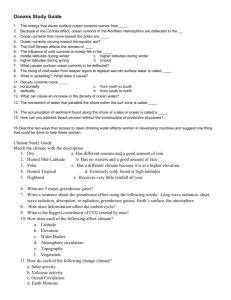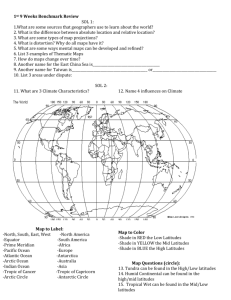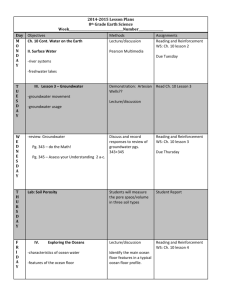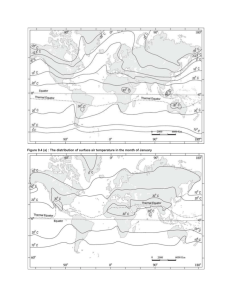THORNTON-ATMS-211-Homework-6-ANSWER
advertisement
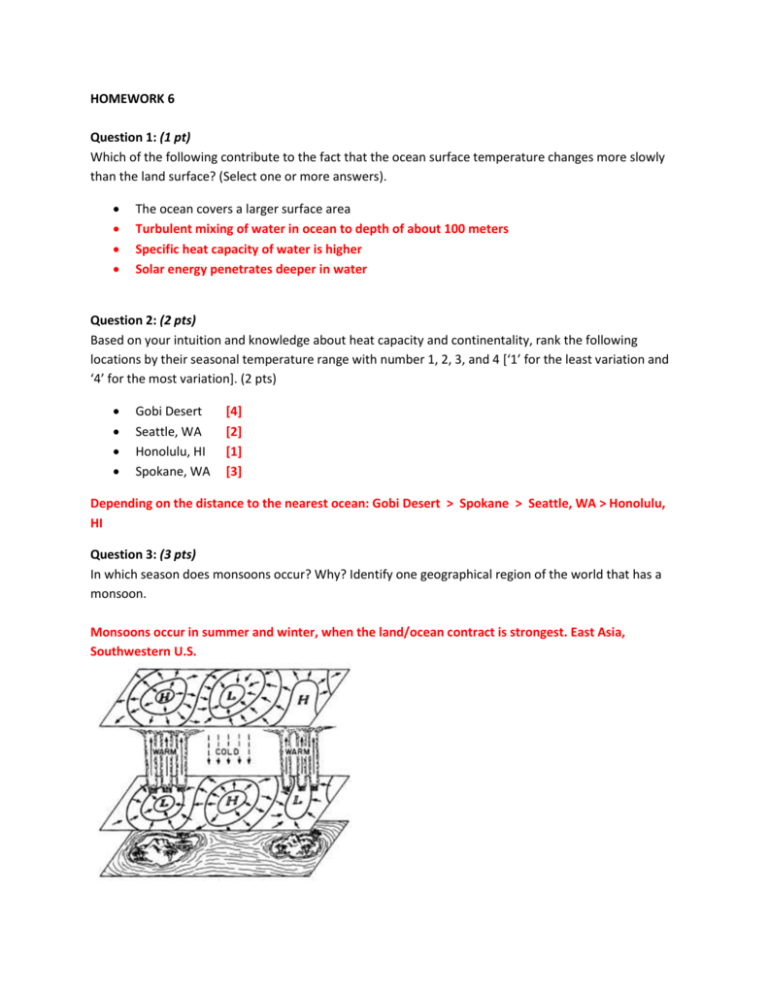
HOMEWORK 6 Question 1: (1 pt) Which of the following contribute to the fact that the ocean surface temperature changes more slowly than the land surface? (Select one or more answers). The ocean covers a larger surface area Turbulent mixing of water in ocean to depth of about 100 meters Specific heat capacity of water is higher Solar energy penetrates deeper in water Question 2: (2 pts) Based on your intuition and knowledge about heat capacity and continentality, rank the following locations by their seasonal temperature range with number 1, 2, 3, and 4 [‘1’ for the least variation and ‘4’ for the most variation]. (2 pts) Gobi Desert Seattle, WA Honolulu, HI Spokane, WA [4] [2] [1] [3] Depending on the distance to the nearest ocean: Gobi Desert > Spokane > Seattle, WA > Honolulu, HI Question 3: (3 pts) In which season does monsoons occur? Why? Identify one geographical region of the world that has a monsoon. Monsoons occur in summer and winter, when the land/ocean contract is strongest. East Asia, Southwestern U.S. Question 4: (1 pt) True or False: Coastal upwelling occurs along the eastern boundary of the ocean in the northern hemisphere and along the western boundary of the ocean in the southern hemisphere. False, along the eastern boundary of the ocean in both hemispheres. Question 5: (1 pt) Surface ocean currents in the Northern Hemisphere Atlantic Ocean (between North America and Europe) form a clockwise rotating gyre. The water just cycles “around and around.” However, these currents serve to transport energy from low latitudes to high latitudes. Explain how. That’s because the latitudal temperature gradient. On the west side, high temperature water is carried to higher latitudes, while on the east side, low temperature water is carried to lower latitudes. Overall, it transports heat from low latitudes to high latitudes. Question 6: (4 pts) Briefly describe what happens to the pattern of sea surface temperature in the Equatorial Pacific Ocean during an El Nino event and also discuss the influence on precipitation patterns in the tropics. During El Nino event, the easterly wind is weaker than usual, the SST is higher than normal (or a positive anomaly) in the east equatorial Pacific Ocean. The high temperature also boost uplift and more precipitation in the ease side. The opposite thing happens in the west side of the ocean, where the SST is cooler, precipitation is suppressed (drier). Question 7: Regarding the hydrological cycle shown in Figure 4-24 in your textbook, calculate the lifetime of water in the three reservoirs (atmosphere, land, and oceans). What’s the meaning of these lifetimes? Lifetime (resident time) = 𝒃𝒖𝒓𝒅𝒆𝒏 (𝒆.𝒈. 𝒎𝒂𝒔𝒔) 𝒇𝒍𝒐𝒘 𝒐𝒖𝒕 Lifetime of US population= 𝟑𝟎𝟎,𝟎𝟎𝟎,𝟎𝟎𝟎 𝟐,𝟓𝟎𝟎,𝟎𝟎𝟎 = 120 years Life expectancy = ~80 years Atmosphere: Lifetime = 0.013e15 / (324e12+99e12) = 0.03 year = ~11 days Land: Lifetime = 33.6e15/(62e12+37e12) = 339 years Ocean: Lifetime = 1350e15/361e12 = 3740 years Question 8: (3 pts) Support or refute the following claim: Global warming will increase perceptible water and thus the total amount of precipitation. Therefore deserts will recede to become grasslands. Refute: even drier in subtropics, indicating expanding desert.




